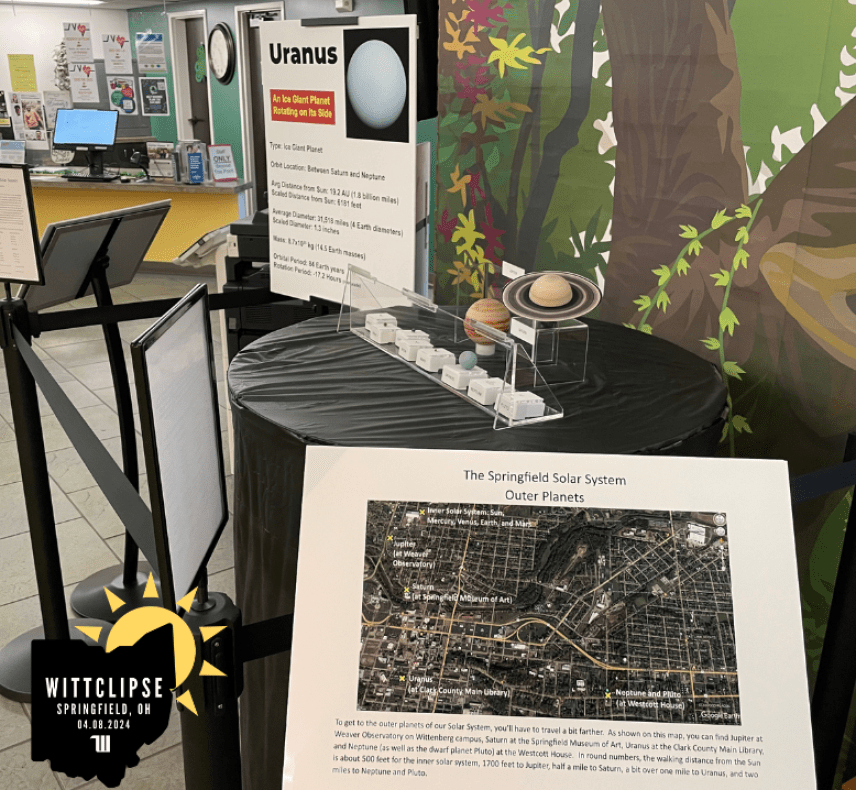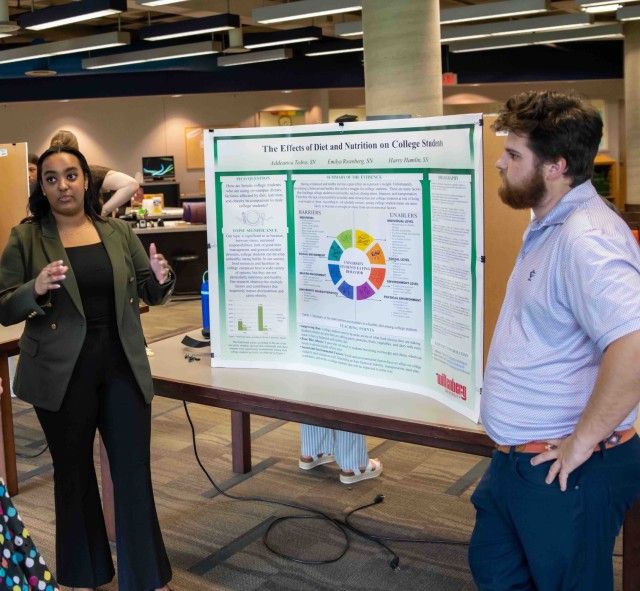Stargazers and space enthusiasts of all ages have one more reason to engage with Wittenberg, thanks to the efforts of award-winning Professor Emeritus of Physics Dan Fleisch. With expertise in electromagnetics and space physics, Fleisch has developed an accurately scaled model of the solar system on campus and at select locations in the surrounding community.
The models consist of 15 planetary information stations all located at the proper distance from the model Sun, which is represented by a three-foot sphere at Edwards-Maurer Field and the Steemer, both part of the Health, Wellness & Athletics Complex at Wittenberg. There will also be a full display at the Thomas Library.
“Each planetary information station will include a large placard with information about the planet or asteroid at that location, along with an accurately scaled model of that planet.,” Fleisch said. “The stations for the Sun, Mercury, Venus, Earth/moon, Mars, Jupiter, and several asteroids will be on Wittenberg campus, but Saturn, Uranus, Neptune, and Pluto are so far away from the Sun that they don't fit on campus.”
Happily, surrounding organizations have agreed to host stations for Fleisch. The Springfield Museum of Art will feature Saturn, the Clark County Public Library will host Uranus, and the Westcott House will house Neptune and Pluto.
Heading into the Great North American Eclipse on April 8, Fleisch has been hard at work, leading several conversations in print and in-person as the big day nears. His goal has been to educate the public on what will transpire during this astronomical event in which the sky will darken as the moon passes between the Sun and the Earth for four minutes across a 115-mile path stretching from Mexico to Maine. Depending on the weather, Springfield is expected to receive more than two minutes of totality.
Fleisch has been visiting several local and regional schools and service organizations to present information about the Sun, the eclipse, and how people can make sure that they view the eclipse safely. Current local engagements have included Horace Mann Elementary School, the Kiwanis Club, the Dayton Regional STEM School, and the University Club. He is also presenting every Sunday at 1 p.m. at Weaver Observatory on campus through April 7. The topics and astronomical presentations are as follows:
- March 17 - Stars
- March 24 - Planets
- March 31 - Cathedrals as Solar Observatories
- April 7 - Total Solar Eclipse Viewing Tips and Safety
His presentations will also be featured in the Springfield News-Sun with accompanying articles by Tom Stafford, Wittenberg class of 1976.
Recipient of the 2004 Alumni Association Award for Distinguished Teaching and the 2010 Ohio Professor of the Year, Fleisch is one of the top 25 science, technology, engineering, and mathematics (STEM) professors in Ohio (read complete bio). Named the Outstanding Faculty Member at the Wittenberg Greek Scholarship Awards in 2000, he also won the Omicron Delta Kappa Award for Excellence in Teaching in 2002. In 2003 and 2005, he was recognized for Faculty Excellence and Innovation by the Southwestern Ohio Council for Higher Education (SOCHE), which recently changed its name to the Strategic Ohio Council for Higher Education. Late last year, he also received the exciting news that the International Astronomical Union Working Group Small Body Nomenclature (WGSBN) voted to name a minor planet in the asteroid belt “17037 Danfleisch.”
Fleisch received his B.S. in physics from Georgetown University and his M.S. and Ph.D. in space physics and astronomy from Rice University. He is a best-selling author, penning six books thus far with Cambridge University Press, including the co-authored work A Student's Guide to the Mathematics of Astronomy with 2001 Wittenberg alumna, astronomer, writer, and professor Julia Kregenow, and his latest releases, A Student's Guide to the Schrödinger Equation and A Student’s Guide to Laplace Transforms. His other books include A Student's Guide to Maxwell's Equations, published by Cambridge University Press in 2008, and A Student's Guide to Vectors and Tensors, published by Cambridge in 2011. Additionally, he co-authored with 2005 Wittenberg physics graduate Professor Laura Kinnaman of Citrus College, A Student's Guide to Waves, published by Cambridge in 2014 and the McGraw-Hill textbook Electromagnetics with Applications with late professor John Kraus of The Ohio State University. Fleisch's student guides have become international best-sellers and have been translated into Japanese, Korean, Chinese, and Italian.
Fleish was also responsible for inviting nationally known astronomer, educator, author, public speaker, TV/radio presenter, and podcaster Dean Regas to campus for a kickoff event on Saturday, March 2, in Bayley Auditorium, inside the Barbara Deer Kuss Science Center. View his presentation here. He and Fleisch each served as an Astronomer-in-Residence at Grand Canyon National Park in Arizona at different times.
On campus, leveraging its position along the path, WittClipse is the brainchild of a committee comprised of experts in astronomy, meteorology, climate change, physics, and more, who have joined together to present a series of activities and events to mark this phenomenon. A range of campus-only activities are scheduled to take place from 11 a.m. to 4 p.m. on April 8 at Edwards-Maurer Field, weather permitting. Fun, interactive games, and food are also expected to be offered in and around the stadium. More information will be forthcoming once more details are confirmed.
Wittenberg will have safety glasses available for students, faculty, and staff. For information on safe viewing of the total eclipse, click here. For more information about eye safety and the eclipse, visit https://eclipse.aas.org/safety.






